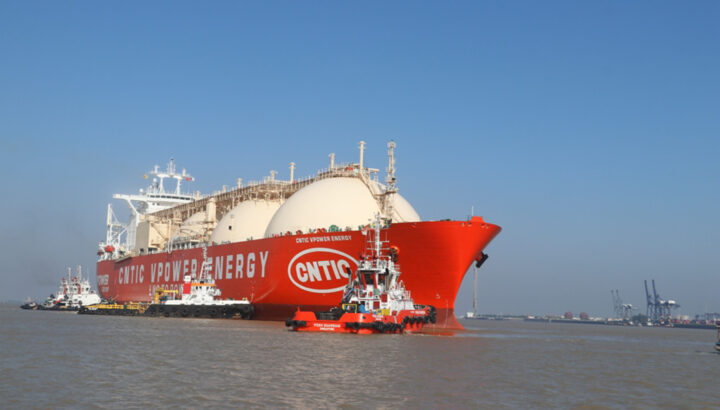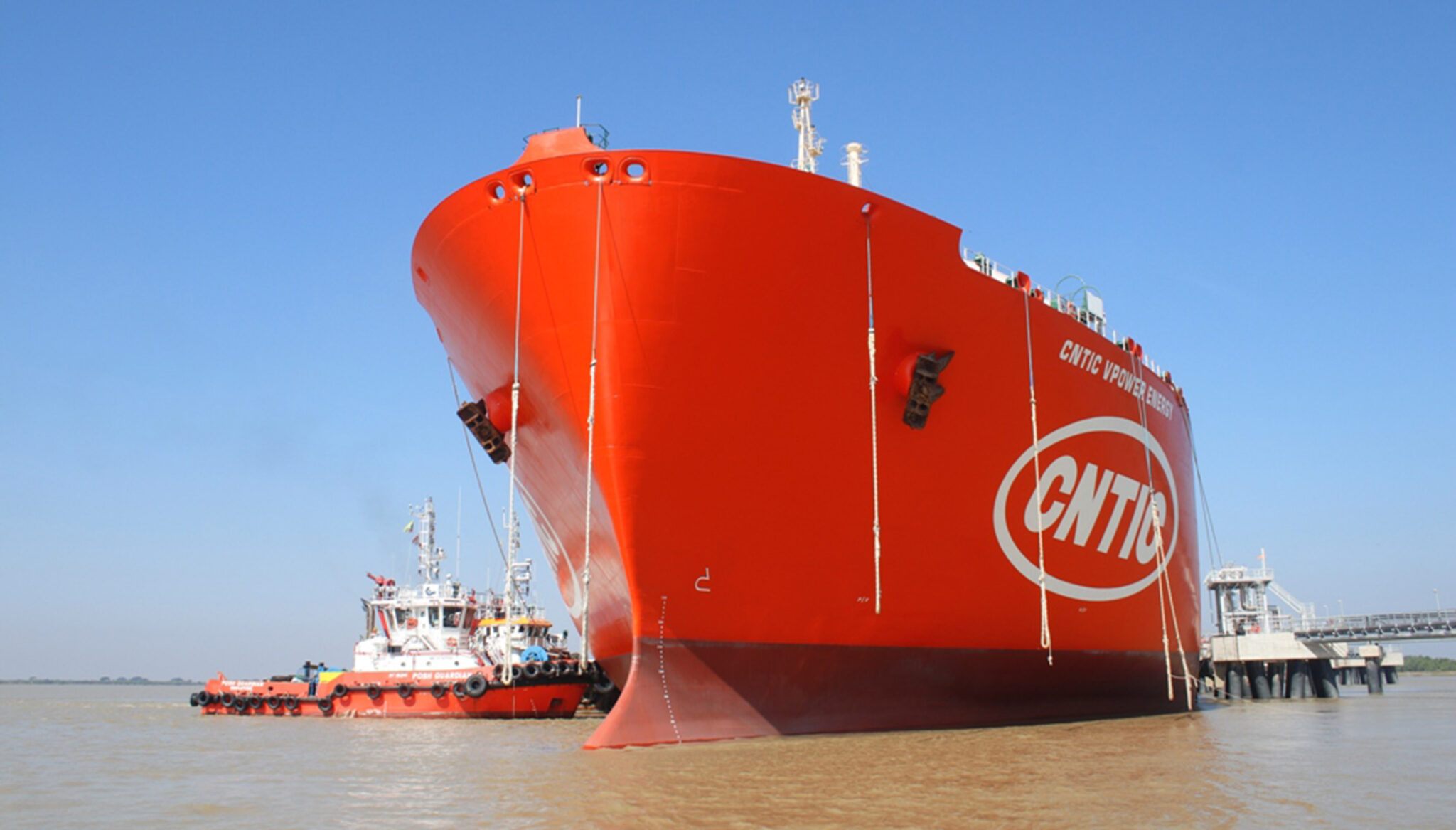By Maung Lwan Ne (Yesagyo)
The breeze blowing through the Yangon River made me warm. A host of sea-going vessels are anchored in the wide river. A scene of a flock of birds slowly flying in the sky seems a flurry and the ships small and big navigating in the river looks like a moving painting.
On the bankside of Yangon River, Dolphin Jetty and Floating Storage Unit (FSU) and LNG Regasification Plant are as part of LNG-to-power project in Myanmar.
Power Generation Project
This site serves a historic location for the Ministry of Electricity and Energy that put the effort in the generation of power by using liquefied natural gas (LNG) for the first time in Myanmar. LNG will be changed into natural gas through the regasification plant, and it will be consumed to generate power after being supplied to local power plants. With the consumption of natural gas sent from the LNG-to-power project 350 MW, Thanlyin power plant and 400 MW Thakayta power plant began power generation and distributed it to where necessary during June in 2020.
The Ministry of Electricity and Energy has set up short-term, mid-term and long-term projects phase by phase for ensuring equitable development in the process of generating, sending and distributing power so as to meet the increasing daily consumption of electricity. With the noticeable socio-economic developments in the country, there has been an enormous increase in the power demand of the people. For that reason, it is required to generate more power than previously expected in a short time.
Continuous efforts in generation power
With the effective use of resources capable of generating power in the country, the Ministry of Electricity and Energy is making every effort to enhance the role of power generation building power plants inviting investments from the private sector on the basis of independent power producer (IPP) system.
Electricity is currently generated with the use of different ways and means such as hydropower, natural gas, coal and solar. It is not easy to fulfil ongoing power demand in a short time as the construction of a hydropower plant has to take time. There has been a gradual decrease in the local production of natural gas. It is impossible to fulfil power demand in a short period despite best efforts in the search for natural gas from on-shore and offshore oil and gas blocks.
For that reason, the Ministry of Electricity and Energy adopted strategies for undertaking the speedy generation of electricity in a short time in order to satisfy the power demand from the people. LNG-to Power plants are to be built as soon as possible by boosting the capacity of department-owned machines producing electricity run with natural gas.
As stated by this strategy, the Ministry of Electricity and Energy set up projects in seven places from regions and states in an effort to generate 1,166 MW during 2020. They are 400 MW Thakayta project, 350 MW Thanlyin project, 151.54 MW Ahlon project in Yangon Region, 70 MW Shwetaung project in Bago Region, 150 MW Kyaukphyu project in Rakhine State, and 66 MW Magway project and 21.54 MW Kyunchaung project in Magway Region.
Magway, Shwetaung, Kyunchaung and Ahlon projects can be operated by using locally-produced natural gas, but Thakayta, Thanlyin and Kyaukphyu projects by using the imported LNG. Among the seven projects, Magway power plant was commissioned into service on 13-12-2019, Ahlon power plant on 31-5-2020, Kyunchaung power plant on 3-6-2020, Thakayta power plant on 8-8-2020, Shwetaung power plant on 30-8-2020, and Thanlyin power plant on 8-10-2020. Now a total of 988 Mw of power can have been sent to the national grid, and the ministry continues trying to generate power from the remaining Kyaukphyu power plant by the summer in 2021.
Priority to be placed on power generation in use of fuel
It is true that Myanmar has a wealth of water sources and possesses advantages capable of generating power in use of renewable energy.
Myanmar’s current situation is to place a priority on the power negation by fuel in order to fulfil a power demand within a short time and help a continuous speedy flow of national grid. Therefore, LNG, a kind of fuel which is the least impact on the natural environment, has been opted for the generation of power and access to LNG on the market must be easy. LNG saw a high price in the past, but now it stands at a reasonable price.
The Ministry of Electricity and Energy chose favourable locations where LNG power plants were built by taking advantages, thereby contributing to high demand for power, easy access to fuel and easy sending of power to the national grid.
The power consumption of Yangon makes up 1,608 MW, accounting for 42% of the nationwide consumption. The power necessary for Yangon is sent from the power plants in the northern and central parts of the country through the very long power lines. The construction of further LNG-to-power plants will ensure full and stable power along with the benefits such as a reduction in power breakdown and power waste and loss.
In addition to that, it will help to boost a low production of natural gas by the State, thereby contributing other industries with the use of basic facilities of the natural gas pipelines already built in the country. The gas-fired power plants already built in the country will be able to run at full capacity as well.
Yangon with a high population density needs to take a reduction in carbon emission into consideration. LNG-to-power plants ensure a reduction in carbon emission as it consumes clean fuel.
Transmission of power to national grid
Letter of Acceptance (L.O.A) was issued to Thakayta and Thanlyin power projects on 6-9-2019. CNTIC VPower YG1 Limited and CNTIC VPower YG2 Limited that respectively won the tenders for Thakayta 400 MW LNG power plant project in Thakayta and Thanlyin 350 MW LNG power plant project in Thilawa began the work in parallel on the same day of 6-9-2019 as soon as L.O.A was received. Even in a short time, power can be sent to the national grid due to the speedy measures in the implementation process, and power can be provided for the State and the people as expected.
Dolphin Jetty had to be built for enabling Floating Storage Unit (FSU) to be berthed for the purpose of distributing LNG fuel to Thakayta and Thanlyin LNG-to-power projects. The Mobile Filling Platform (MFP) had to be quickly built to help the power plants run by LNG during the time of constructing the Dolphin Jetty. MV CNTIC VPower Global carrying first-ever LNG 28000m3 to Myanmar managed to successfully dock on 6 June in 2020. At the same time, a new chapter for LNG-to-power project could be open in Myanmar’s electric power sector.
Systematic arrangements are being made so as to provide LNG fuel for LNG-to-power projects without any shortage. LNG Mother Vessel MV Methane Alison Victoria capable of storing LNG 140,000 m3 is anchored near Thameehla Islands in Myeik Archipelago. The LNG from Mother Vessel is transported again to Thilawa by two Shuttles. For the first step, LNG has to be carried to the large vessel capable of storing LNG 28,000 m3 which berths as the FSU during which the Dolphin Jetty is under construction.
Arrival of MV CNTIC VPower Energy to Dolphin Jetty
The construction of the Dolphin Jetty has been currently completed. MV CNTIC VPower Energy capable of storing 120,000m3 LNG has already arrived in place of Dolphin Jetty where MV CNTIC VPower Global carrying first-ever LNG 28,000m3 was originally used as the temporary FSU. The MV CNTIC VPower Global which was originally used as the temporary FSU will continue transporting LNG en route from Myeik to Thilawa as the LNG Shuttle.
November 26th of 2020 when MV CNTIC VPower Energy capable of storing 120,000m3 LNG could be successfully berthed at Dolphin Jetty is a historic day for the Ministry of Electricity and Energy setting a new record along Yangon River. The large vessel is 272-metre in length with 9-metre sounding and total tonnage of 106,283.
The construction of Mobile Filling Platform, the arrival of LNG storage vessels and power generation by LNG are a first-hand experience for Myanmar. The Ministry of Electricity and Energy achieved success in the implementation of overcoming difficulties and challenges during the ongoing Covid-19 crisis.
In the group of plants in Thakayta, Max Power Company Limited-owned 50MW gas engine plant on the basis of IPP/BOT, U Energy Company Limited-owned 106MW plant on the basis of JV/BOT and State-owned 154MW plants are all in the process of generating power now. 400 MW LNG-to-power has already been built in Thakayta, and so a group of plants in Thakayta adds up to 710MW, and has now become a major power distribution place. The power coming from the plants is supplied to Dagon Myothit (South) and Dagon Myothit (North), Thakayta, Mayangon, Botahtaung, Bahan and Dawbon through sub-power station of Thakayta and the surplus power to the national grid via 230KV power lines.
Sufficient power to be consumed
Sufficient power will be able to be supplied not only to the industrial zones and Thilawa Special Economic Zone in Thanlyin and Kyauktan but also to techan nological development zone in Htantabin, industrial garden project in Hlegu, urban infrastructure facilities in Yangon area. Full access to power is of great importance in a bid to develop a nation. With that notion, the Ministry of Electricity and Energy is striving for a full percentage consumption of power across the country in 2030 as expected.
Translated by Htut Htut (Twantay)




